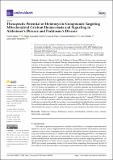Por favor, use este identificador para citar o enlazar a este item:
http://hdl.handle.net/10261/330365COMPARTIR / EXPORTAR:
 SHARE SHARE
 CORE
BASE CORE
BASE
|
|
| Visualizar otros formatos: MARC | Dublin Core | RDF | ORE | MODS | METS | DIDL | DATACITE | |

| Título: | Therapeutic Potential of Heterocyclic Compounds Targeting Mitochondrial Calcium Homeostasis and Signaling in Alzheimer’s Disease and Parkinson’s Disease |
Autor: | Tapias, Víctor CSIC ORCID; González-Andrés, Paula; Peña, Laura F.; Barbero, Asunción; Núñez, Lucía CSIC ORCID; Villalobos, Carlos CSIC ORCID | Palabras clave: | Alzheimer’s disease Parkinson’s disease Mitochondria Oxidative stress Calcium Heterocyclic compounds |
Fecha de publicación: | 15-jun-2023 | Editor: | Multidisciplinary Digital Publishing Institute | Citación: | Antioxidants 12(6): 1282 (2023) | Resumen: | Alzheimer’s disease (AD) and Parkinson’s disease (PD) are the two most common neurodegenerative diseases in the elderly. The key histopathological features of these diseases are the presence of abnormal protein aggregates and the progressive and irreversible loss of neurons in specific brain regions. The exact mechanisms underlying the etiopathogenesis of AD or PD remain unknown, but there is extensive evidence indicating that excessive generation of reactive oxygen species (ROS) and reactive nitrogen species (RNS), along with a depleted antioxidant system, mitochondrial dysfunction, and intracellular Ca2+ dyshomeostasis, plays a vital role in the pathophysiology of these neurological disorders. Due to an improvement in life expectancy, the incidence of age-related neurodegenerative diseases has significantly increased. However, there is no effective protective treatment or therapy available but rather only very limited palliative treatment. Therefore, there is an urgent need for the development of preventive strategies and disease-modifying therapies to treat AD/PD. Because dysregulated Ca2+ metabolism drives oxidative damage and neuropathology in these diseases, the identification or development of compounds capable of restoring Ca2+ homeostasis and signaling may provide a neuroprotective avenue for the treatment of neurodegenerative diseases. In addition, a set of strategies to control mitochondrial Ca2+ homeostasis and signaling has been reported, including decreased Ca2+ uptake through voltage-operated Ca2+ channels (VOCCs). In this article, we review the modulatory effects of several heterocyclic compounds on Ca2+ homeostasis and trafficking, as well as their ability to regulate compromised mitochondrial function and associated free-radical production during the onset and progression of AD or PD. This comprehensive review also describes the chemical synthesis of the heterocycles and summarizes the clinical trial outcomes. | Versión del editor: | https://doi.org/10.3390/antiox12061282 | URI: | http://hdl.handle.net/10261/330365 | DOI: | 10.3390/antiox12061282 | E-ISSN: | 2076-3921 |
| Aparece en las colecciones: | (IBGM) Artículos |
Ficheros en este ítem:
| Fichero | Descripción | Tamaño | Formato | |
|---|---|---|---|---|
| Therapeutic_Potential_Tapias.pdf | 4,04 MB | Adobe PDF |  Visualizar/Abrir |
CORE Recommender
SCOPUSTM
Citations
1
checked on 24-abr-2024
WEB OF SCIENCETM
Citations
1
checked on 19-feb-2024
Page view(s)
32
checked on 30-abr-2024
Download(s)
19
checked on 30-abr-2024
Google ScholarTM
Check
Altmetric
Altmetric
Este item está licenciado bajo una Licencia Creative Commons

